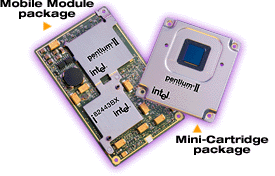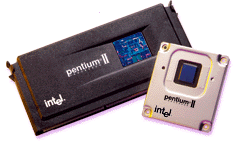Sony VAIO PCG-818 Pentium II 300 Notebook
by Anand Lal Shimpi on January 19, 1999 2:52 PM EST- Posted in
- Systems
Turning it inside out
| At the heart of the PCG-818 is Intel's latest mobile processor, the mobile Pentium II running at 300MHz. The beauty of the mobile Pentium II processor is its low profile design, allowing it to plug in directly to the motherboard and occupy a very small amount of vertical real estate, which is key to making a thin laptop. Since the processor is barely elevated over the surface of the motherboard, placing a low-profile heatsink/fan on top of the processor to channel the heat away from the source becomes quite a simple task. |  |
| In order to make cooling less of a Herculean task, the mobile Pentium II is designed to run at a lower core voltage in comparison to the desktop Pentium II processors we're used to using. Instead of operating at 2.0v, like most newer desktop Pentium II processors, the mobile Pentium II, like the Pentium III, operates at a 1.8v core voltage effectively decreasing the power consumption of the CPU as well as the heat dissipated by the 300MHz demon. | |
Performance wise, there is no real difference between a desktop and a laptop Pentium II 300, the real performance differences become apparent between desktops and laptops when you factor in the video and mainboard chipsets, two areas manufacturers often skimp on to cut costs when making a "high-end" laptop. The perfect example would be the PCG-818, although it makes use of the same 440BX chipset found in desktop computers, the PCG-818 lacks one major feature of the desktop BX chipset, which is AGP support. The lack of AGP support on the PCG-818 immediately makes the laptop a poor buy for anyone that might be using the laptop for games, or anyone that is interested in the long term value of the notebook. Most newer laptops are coming shipped with ATI Rage Pro AGP 2X compliant video chipsets on-board, however Sony chose to forego that route in favor of a cheaper 2.5MB PCI NeoMagic MagicMedia graphics accelerator.
| Although the MagicMedia accelerator supports both Direct3D and MPEG acceleration it fails to provide the performance a 300MHz Pentium II should be paired up with. Naturally there are power consumption and heat considerations that Sony had to take into account, making an on-board Voodoo2 or TNT accelerator out of the question, however an AGP ATI accelerator would've been preferred over Sony's chosen solution with NeoMagic. |  |
As briefly mentioned before, the PCG-818 comes equipped with a removable 2X DVD-ROM (it also doubles as a 20X CD-ROM) drive and a software DVD decoder capable of playing full speed, full screen DVD-movies with extremely high quality playback comparable to that of a home unit. Smooth playback is possible, although only while running the notebook at full speed, if Sony's power management utility kicks in expect to see extremely choppy playback of your video until you restore the laptop to its full speed. Of course there is only so much entertainment you can get from the tiny speakers tucked carefully away underneath the monitor on the PCG-818, and in an airplane you're going to want something a little closer to home for sound, in which case it's time to break out the trusty headphones Sony provided with the laptop. The headphones are your standard Sony ear-piece headphones, so you'll probably not want to share them with your neighbor for sanitary reasons, and they concentrate the sound close enough to your ears that you get a much better overall experience out of the DVD player when using the headphones rather than the built-in speakers. A unique feature of Sony's bundled headphones is the wired remote that they plug into, which then plugs into the laptop allowing you to adjust the volume, skip from track to track when playing a CD, stop playback, and pause all from the palm of your hand. It's a neat little gadget, although after connecting the headphones to the wired remote and then it to the laptop AnandTech had a nice little tangled mess to play around with.
While the removable DVD drive is not in use, the sole removable drive bay can be occupied by either the supplied Floppy Drive or by an optional second battery pack. Since the floppy drive is very rarely used, in order to save weight on your should or on your lap you may want to install the bundled weight saver which is nothing more than a plastic cover for the bay until you can find another movie to pop in the DVD drive. Should the need arise that you have both the DVD and the floppy drives available for use at the same time, Sony allows you to make use of the parallel port interface on the back to connect the floppy to and leaves the DVD drive safe and sound in the removable bay. Unfortunately the DVD drive is not hot swappable, in that you must reboot the computer after installing the DVD drive in the removable bay, which can be quite a bit annoying at times.
At the same time, while you're playing around with the removable drive bay on the right side of the PCG-818, there are two pretty much standard features on the 818 that are noteworthy. The removable 2.5" EIDE Toshiba 6.4GB HDD positioned towards the back of the laptop on the left hand side is a standard sized notebook hard drive, and easily slides out of its removable bay for quick replacement. The bay can accept all 2.5" notebook drives, however whether or not the on-board BIOS can detect drives larger than 9GB is still up for question, it should, but you never know. Before upgrading the hard drive in the 818 you'll want to confirm that the BIOS does support drives larger than 9GB with Sony just to be on the safe side.
Towards the front of the laptop you'll find the removable battery bay occupied by the supplied rechargeable Lithium Ion battery. Although Sony claims a maximum battery life of 4 hours for the single battery, in reality you can expect the battery to last a little over two hours, just enough to watch a full length DVD movie. Sony also allows for an optional second battery to be installed in the removable drive bay, effectively doubling the battery life of the laptop. A second battery is definitely recommended for any long trips without access to a wall outlet for recharging, although the battery itself will run you an extra $240. At the time of the review, Sony was offering a $150 rebate on an additional battery pack however that offer may not be valid during the time of publication.










0 Comments
View All Comments